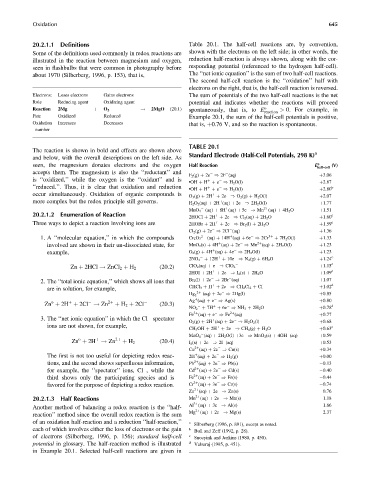Page 690 - Fundamentals of Water Treatment Unit Processes : Physical, Chemical, and Biological
P. 690
Oxidation 645
20.2.1.1 Definitions Table 20.1. The half-cell reactions are, by convention,
Some of the definitions used commonly in redox reactions are shown with the electrons on the left side; in other words, the
illustrated in the reaction between magnesium and oxygen, reduction half-reaction is always shown, along with the cor-
seen in flashbulbs that were common in photography before responding potential (referenced to the hydrogen half-cell).
about 1970 (Silberberg, 1996, p. 153), that is, The ‘‘net ionic equation’’ is the sum of two half-cell reactions.
The second half-cell reaction is the ‘‘oxidation’’ half with
electrons on the right, that is, the half-cell reaction is reversed.
Electrons: Loses electrons Gains electrons The sum of potentials of the two half-cell reactions is the net
Role Reducing agent Oxidizing agent potential and indicates whether the reactions will proceed
Reaction 2Mg O 2 ! 2MgO (20.1) spontaneously, that is, to E o > 0. For example, in
reaction
þ
Fate Oxidized Reduced Example 20.1, the sum of the half-cell potentials is positive,
Oxidation Increases Decreases that is, þ0.76 V, and so the reaction is spontaneous.
number
TABLE 20.1
The reaction is shown in bold and effects are shown above a
Standard Electrode (Half-Cell Potentials, 298 K)
and below, with the overall descriptions on the left side. As
seen, the magnesium donates electrons and the oxygen Half Reaction E o (V)
half-cell
accepts them. The magnesium is also the ‘‘reductant’’ and
F 2 (g) þ 2e ) 2F (aq) þ3.06
is ‘‘oxidized,’’ while the oxygen is the ‘‘oxidant’’ and is . OH þ H þ e ) H 2 O(l) þ2.87
þ
‘‘reduced.’’. Thus, it is clear that oxidation and reduction . OH þ H þ e ) H 2 O(l) þ2.80 b
þ
occur simultaneously. Oxidation of organic compounds is O 3 (g) þ 2H þ 2e ) O 2 (g) þ H 2 O(l) þ2.07
þ
more complex but the redox principle still governs. H 2 O 2 (aq) þ 2H (aq) þ 2e ) 2H 2 O(l) þ1.77
þ
MnO 4 (aq) þ 8H (aq) þ 5e ) Mn (aq) þ 4H 2 O þ1.51
2þ
þ
20.2.1.2 Enumeration of Reaction 2HOCl þ 2H þ 2e ) Cl 2 (aq) þ 2H 2 O þ1.60 c
þ
Three ways to depict a reaction involving ions are 2HOBr þ 2H þ 2e ) Br 2 (l) þ 2H 2 O þ1.59 c
þ
Cl 2 (g) þ 2e ) 2Cl (aq) þ1.36
1. A ‘‘molecular equation,’’ in which the compounds Cr 2 O 7 2 (aq) þ 14H (aq) þ 6e ) 2Cr 3þ þ 7H 2 O(l) þ1.33
þ
involved are shown in their un-dissociated state, for MnO 2 (s) þ 4H (aq) þ 2e ) Mn (aq) þ 2H 2 O(l) þ1.23
þ
2þ
example, O 2 (g) þ 4H (aq) þ 4e ) 2H 2 O(l) þ1.23
þ
2NO 3 þ 12H þ 10e ) N 2 (g) þ 6H 2 O þ1.24 c
þ
Zn þ 2HCl ! ZnCl 2 þ H 2 (20:2) ClO 2 (aq) þ e ) ClO 2 þ1.15 c
2HOI þ 2H þ 2e ) I 2 (s) þ 2H 2 O þ1.09 c
þ
2. The ‘‘total ionic equation,’’ which shows all ions that Br 2 (l) þ 2e ) 2Br (aq) þ1.07
CHCl 3 þ H þ 2e ) CH 2 Cl 2 þ Cl þ1.02 d
þ
are in solution, for example,
2þ (aq) þ 2e ) 2Hg(l) þ0.85
Hg 2
Ag (aq) þ e ) Ag(s) þ0.80
þ
o
Zn þ 2H þ 2Cl ! Zn 2þ þ H 2 þ 2Cl (20:3)
þ
NO 2 þ 7H þ 6e ) NH 3 þ 2H 2 O þ0.78 d
þ
Fe (aq) þ e ) Fe (aq) þ0.77
3þ
2þ
3. The ‘‘net ionic equation’’ in which the Cl spectator
O 2 (g) þ 2H (aq) þ 2e ) H 2 O 2 (l) þ0.68
þ
ions are not shown, for example, c
CH 3 OH þ 2H þ 2e ) CH 4 (g) þ H 2 O þ0.63
þ
MnO 4 (aq) þ 2H 2 O(l) þ3e ) MnO 2 (s) þ 4OH (aq) þ0.59
o
Zn þ 2H ! Zn 2þ þ H 2 (20:4) I 2 (s) þ 2e ) 2I (aq) þ0.53
þ
Cu (aq) þ 2e ) Cu(s) þ0.34
2þ
The first is not too useful for depicting redox reac- 2H (aq) þ 2e ) H 2 (g) þ0.00
þ
tions, and the second shows superfluous information, Pb (aq) þ 2e ) Pb(s) 0.13
2þ
for example, the ‘‘spectator’’ ions, Cl , while the Cd (aq) þ 2e ) Cd(s) 0.40
2þ
third shows only the participating species and is Fe (aq) þ 2e ) Fe(s) 0.44
2þ
favored for the purpose of depicting a redox reaction. Cr (aq) þ 3e ) Cr(s) 0.74
3þ
Zn (aq) þ 2e ) Zn(s) 0.76
2þ
20.2.1.3 Half Reactions Mn (aq) þ 2e ) Mn(s) 1.18
2þ
Another method of balancing a redox reaction is the ‘‘half- Al (aq) þ 3e ) Al(s) 1.66
3þ
2þ
reaction’’ method since the overall redox reaction is the sum Mg (aq) þ 2e ) Mg(s) 2.37
of an oxidation half-reaction and a reduction ‘‘half-reaction,’’ a
Silberberg (1996, p. 891), except as noted.
each of which involves either the loss of electrons or the gain b Bull and Zeff (1992, p. 28).
of electrons (Silberberg, 1996, p. 156); standard half-cell c Snoeyink and Jenkins (1980, p. 450).
potential in glossary. The half-reaction method is illustrated d Valsaraj (1995, p. 451).
in Example 20.1. Selected half-cell reactions are given in

